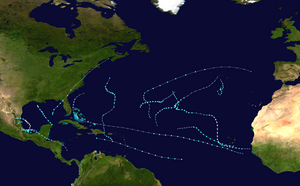
Back Atlantische Hurrikansaison 2013 German Temporada de huracanes en el Atlántico de 2013 Spanish Vuoden 2013 Atlantin hurrikaanikausi Finnish Saison cyclonique 2013 dans l'océan Atlantique nord French 2013년 북대서양 허리케인 Korean Atlantisch orkaanseizoen 2013 Dutch Temporada de furacões no oceano Atlântico de 2013 Portuguese 2013 Atlantic hurricane season SIMPLE ฤดูพายุเฮอริเคนแอตแลนติก พ.ศ. 2556 Thai 2013年大西洋颶風季 Chinese
| 2013 Atlantic hurricane season | |
|---|---|
 Season summary map | |
| Seasonal boundaries | |
| First system formed | June 5, 2013 |
| Last system dissipated | December 7, 2013 |
| Strongest storm | |
| Name | Humberto |
| • Maximum winds | 90 mph (150 km/h) (1-minute sustained) |
| • Lowest pressure | 979 mbar (hPa; 28.91 inHg) |
| Seasonal statistics | |
| Total depressions | 15 |
| Total storms | 14 |
| Hurricanes | 2 (record low in the satellite era, tied with 1982) |
| Major hurricanes (Cat. 3+) | 0 |
| Total fatalities | 56 total |
| Total damage | ≥ $1.76 billion (2013 USD) |
| Related articles | |
The 2013 Atlantic hurricane season was a well below average Atlantic hurricane season in terms of the number of hurricanes. It was the first since 1994 with no major hurricanes, Category 3 or higher on the Saffir–Simpson scale, and the first in the satellite era where no hurricanes reached Category 2 strength. Altogether, the season produced 15 tropical cyclones, of which all but one became a named storm. The season officially began on June 1, and ended on November 30. These dates historically describe the period in each year when most tropical cyclogenesis occurs in the North Atlantic and are adopted by convention.[1] The first storm of the season, Andrea, developed on June 5, while the last, an unnamed subtropical storm, dissipated on December 7. Throughout the year, only two storms, Humberto and Ingrid, reached hurricane strength; this was the lowest seasonal total since 1982.
The season's overall impact was minimal; although 15 tropical cyclones developed, most were weak or remained at sea. Tropical Storm Andrea killed four people after making landfall in Florida and moving up the East Coast of the United States. In early July, Tropical Storm Chantal moved through the Windward Islands, causing one fatality, but minimal damage overall. Tropical storms Dorian and Erin and Hurricane Humberto brought only squally weather to the Cape Verde Islands. Mexico, where Hurricane Ingrid, Tropical Depression Eight, and tropical storms Barry and Fernand all made landfall, was the hardest hit; Ingrid alone caused at least 32 deaths and $1.5 billion (2013 USD) in damage.[nb 1] In early October, Karen brought showers and gusty winds to the central Gulf Coast of the United States, before impacting the U.S. East Coast as a long-lived nor'easter.
All major forecasting agencies predicted an above-average season. All reduced their seasonal predictions in early August, but even the revised predictions were too high. The lack of activity was primarily caused by an unexpected significant weakening of the Atlantic Ocean thermohaline circulation between winter and spring. This resulted in continuation of the spring weather pattern over the Atlantic Ocean, with strong vertical wind shear, mid-level moisture, and atmospheric stability, which suppressed tropical cyclogenesis.
- ^ "Hurricanes Frequently Asked Questions". Miami, Florida: Atlantic Oceanographic and Meteorological Laboratory. June 3, 2023. Archived from the original on September 17, 2021. Retrieved July 13, 2022.
Cite error: There are <ref group=nb> tags on this page, but the references will not show without a {{reflist|group=nb}} template (see the help page).